Avoid emulsifiers and other unwanted ingredients and control the process by making your own homemade chocolate bars from cocoa nibs.
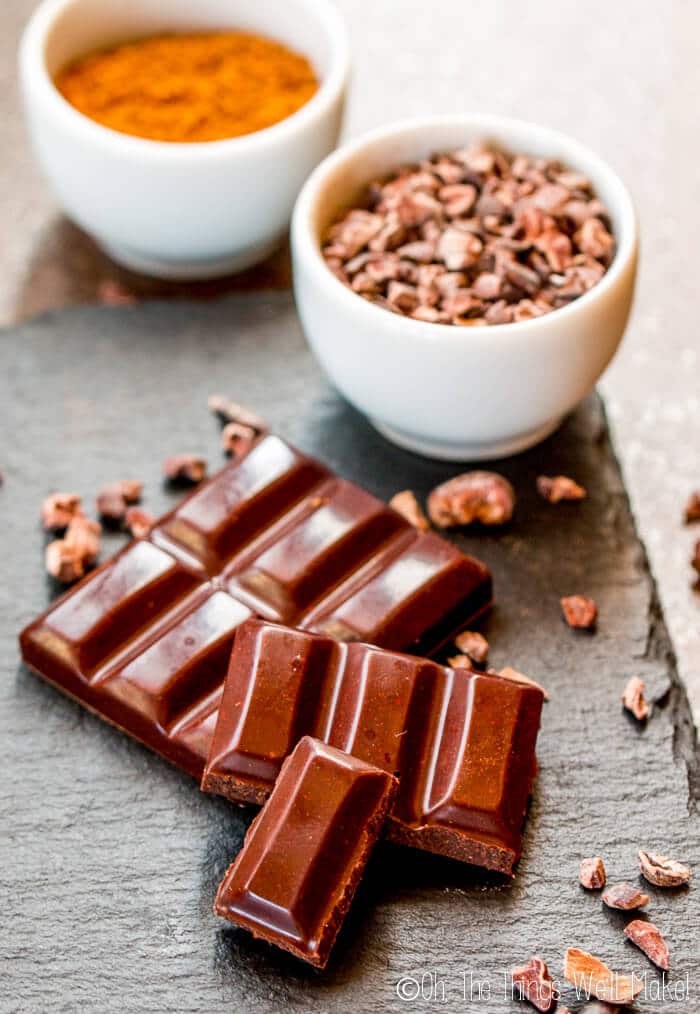
This post comes as a result of experimentation after having bought some cocoa nibs. It was mostly out of curiosity to try to figure out how to make chocolate from scratch. I had read a bit about the whole chocolate making process before, but I hadn’t really experimented with using cocoa nibs for anything.
Cocoa nibs vs. Cacao nibs
First, let’s tackle the whole “cocoa” vs. “cacao” issue. This is only an issue in English as in Spanish all cacao is called cacao because, well, “cacao” is really just “cocoa” in Spanish. When I was a kid, all cocoa powder and cocoa nibs were called just that, “cocoa” powder and nibs. That was also at a time when I remember my mom having carob chips at home as the healthy alternative to chocolate chips.
Since then, though, a lot has changed. Chocolate, or at least cocoa (or, if you prefer, cacao), has been found to have health benefits. Not all chocolates are equal, though, especially considering that milk chocolate has a lot of added sugar (and milk, of course). The same goes for hot “cocoa,” which is usually made from a highly processed drink powder filled with lots of sugars, emulsifiers, thickeners, and, well, cocoa powder.
The need to distinguish the “good” powder from the “bad” sweetened cocoa powders that have other additives is probably what spawned the use of different terminology in the first place. “Cacao” is now usually used to specify that the powder (and nibs, and butter) have been extracted without an excess amount of heat. It is marketed as a raw “superfood.” It is often said that cacao powder, then, is much healthier than cocoa powder because the heat doesn’t kill off all of its beneficial properties.
What does “raw cacao” even mean?
The problem is that the terminology is controversial. Those who make chocolate will argue that even the natural fermentation process used to process the cocoa beans will result in them reaching temperatures that are higher than those normally stated as the temperatures “raw” foods can’t reach. (“Raw” is sort of like “natural” in that it’s a term that isn’t really regulated, so you’re not really sure what it means most of the time.) You can read more about the fermenting process here.
While it is possible to process them without reaching high temperatures, most people say it’s not really a good idea because most cocoa beans aren’t processed in optimal hygiene conditions in the countries where most chocolate it processed.
The truth about cacao is that it’s almost impossible to know if you’re really getting a superior product when you buy cacao vs. cocoa powder as the terminology isn’t really regulated either. I’m not saying don’t buy cacao powder, but do want to make you aware of the situation so that you can make an informed decision and buy whatever cocoa or cacao you prefer.
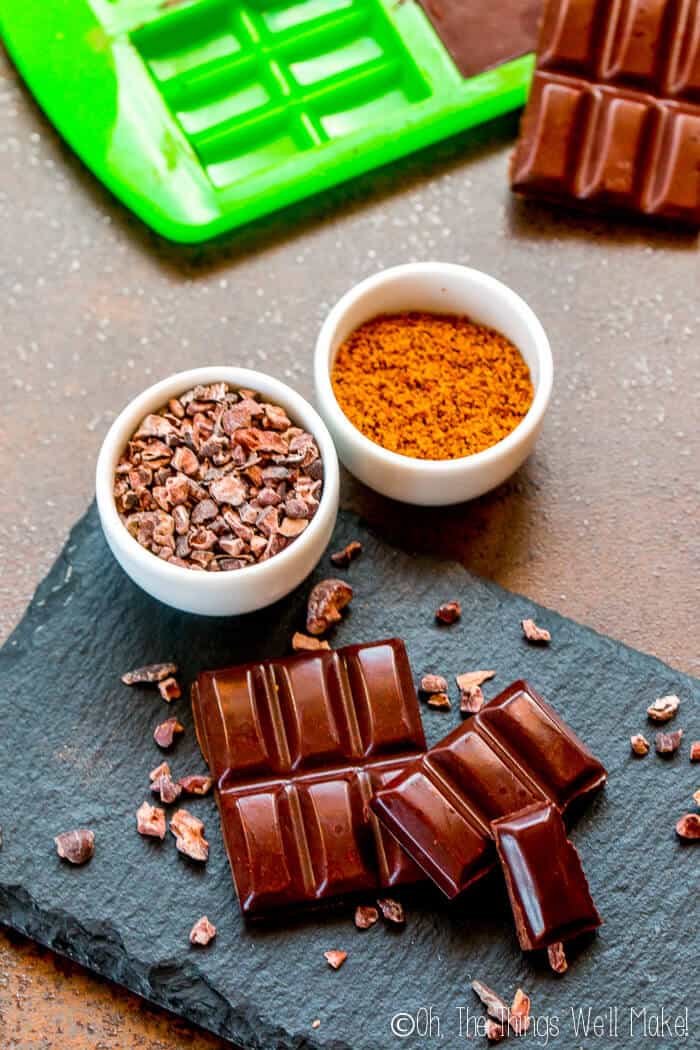
How to make cocoa powder (or cacao powder)
As much as I’d love to share with you a tutorial for how to make cocoa powder, it isn’t something that I think we can easily accomplish at home, at least not if we want to approximate what we normally buy in the store. Common sense would have you believe that grinding up cocoa nibs would leave you with cocoa powder. I guess, in a way, that’s true, sort of. You can make a sort of cocoa powder by grinding up cocoa beans, but that’s not what we normally are buying in the store.
If you’ve ever tried grinding up cocoa nibs, you’ll find that, at first, you do begin to make a sort of coarse cocoa powder. If you keep grinding, though, you won’t end up with a finer, fluffier cocoa powder, but instead will end up with melted chocolate! That’s because the nibs include both the cocoa powder part along with the cocoa butter part. As you grind, the grinding action itself generates heat that begins to melt the cocoa butter, leaving you with a soupy mixture of cocoa powder suspended in cocoa butter.
Here in Spain, the ingredient listed on unsweetened cocoa powder is “cacao desgrasado,” meaning cocoa with the fat removed. I was always curious about why they would want to remove the fat from the cocoa powder, but then, when trying to grind it too fine, I realized why.
Cocoa powder is made by grinding up the cocoa nibs, but that first result is basically melted chocolate. The light colored cocoa butter is then removed, which is great for using in lotions and balms, and the leftover dark colored material left behind can be finely ground into what we know as cocoa powder.
Watch us make homemade chocolate from cocoa nibs:
Dutch processed vs. natural cocoa powder
It took me years to figure out that there were actually several ways to process the cocoa powder, resulting in different types of cocoa powder. While I don’t really think that there is usually much of a difference (if any) between cocoa powder and cacao powder, there is an obvious difference between the different types of cocoa powder.
In the US, most cocoa powder is the “natural” kind. It is made, as I stated above, in the section about how to make cocoa powder. Here in Spain, though, the cocoa powder that is most typically sold in the store tends to be a much darker, flavorful cocoa powder. When I first wanted to make the switch from the supermarket brand cocoa powder to the stuff in the health food stores, I couldn’t figure out why all of the health food brands seemed so much lighter and less flavorful. I kept trying brand after brand until I finally figured out what was going on.
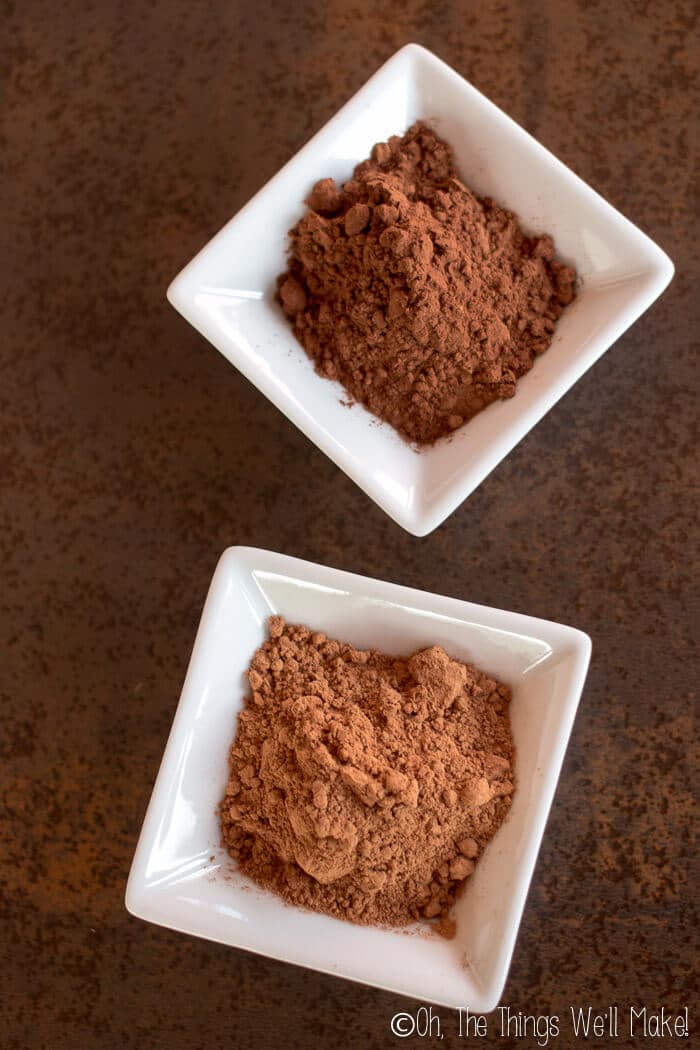
The supermarket brand cocoa powder had been alkalinized in what is called “Dutch processing.” The idea is that the pH of the cacao, which is normally on the acidic side, is alkalinized with potassium carbonate bringing it to a more neutral or even an alkaline pH. This gives the powder a darker hue and makes the flavor smoother and more reminiscent of black, dark chocolate. Being the type of person who loves dark chocolate and sticks her nose in the air up at milk chocolate, I have to admit that I prefer the color and flavor of Dutch processed cocoa.
The difference isn’t just in the appearance and flavor, though. Because the pH is different, it can react differently in recipes. If a recipe uses baking soda as the rising agent, it was probably meant to work with the acidity of “normal” cocoa powder. Just as vinegar and baking soda combine to give a bubbly chemical reaction that releases carbon dioxide, some recipes rely on the same sort of reaction where the gas released helps keep the cake from being too dense. Recipes meant for Dutch processed cocoa are more likely to call for baking powder, whose pH is more neutral. (Switching one for the other in recipes that don’t need a leavening agent is fine.)
Making homemade chocolate from cacao nibs
I’ve already hinted at the process of making chocolate from scratch with cocoa (or cacao) nibs. It’s actually quite simple, and you really only need to blend the nibs until you end up with what is basically melted chocolate. The nibs include the fat of the cocoa beans, the cocoa butter, and the chocolate flavor and color you’re accustomed to seeing in cocoa powder and whatever is made with it.
As you process your cocoas nibs, they will release more of the fat, and the heat of the blending process liquifies the cocoa butter into an oil so you end up with a liquid. If you’ve ever made homemade coconut butter (or even almond butter or peanut butter), you’ll find that the process is very similar. How long it takes will depend on your food processor.
Making a smooth chocolate
I love making my own chocolate from scratch using whatever cocoa nibs and whatever type of sugar I choose, but I would like to warn you that homemade chocolate made with a food processor will have a grainy texture. For somebody who eats chocolate by biting into it and chewing it, it isn’t too much of an issue. For those, like me, who like to have chocolate melt in your mouth slowly and to experience the smoothness of a well-milled chocolate, then food processor chocolate might not leave you 100% satisfied.
To make chocolate that is completely smooth, the cocoa nibs are normally ground for many hours using a wet grinder that is also known as a melanger or chocolate refiner. I haven’t had the pleasure of using one (yet!), but love the idea of using one for making perfectly smooth chocolate. It would also be great for grinding up some smooth coconut butter and almond butter!
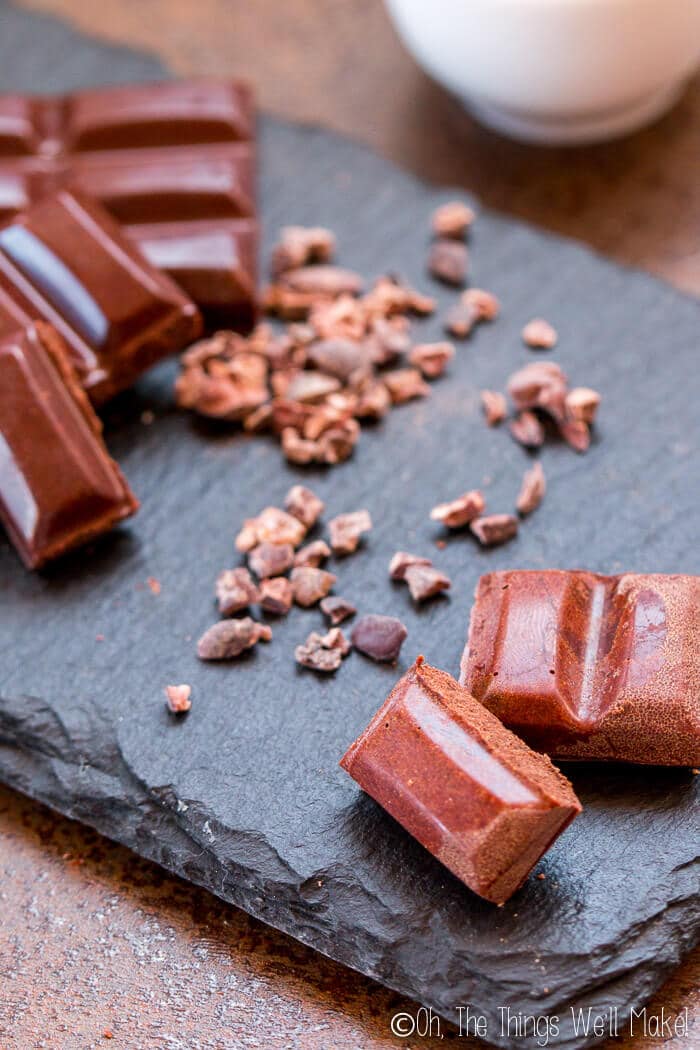
Calculating the chocolate percentage (And should you add cocoa butter?)
I’m not too picky about making a specific percentage of chocolate, and normally just go by taste. I grind down the cocoa nibs and slowly add sugar until I’m happy with the final results. That said, if you are wanting to make a specific type of chocolate, say a 70% chocolate, you’ll want to calculate the amount based on the percentage of cocoa nibs used.
70% chocolate
So, let’s say you want to make 500g of 70% chocolate. You’ll want to use 350g cocoa nibs which is the equivalent of 70% of the 500g of chocolate.
What do you end up using for the other 30%?
Well, you could add 150g of sugar, or you can divide up those 150g and use several other ingredients.
Adding cocoa butter
Many people add cocoa butter. While it isn’t necessary (cocoa butter is already present in the cocoa nibs), it can make the process move along more quickly. This is especially helpful if your food processor isn’t especially potent. It may also help you get a slightly smoother chocolate. Normally one would add about 1/5th of the 30% in weight of cocoa butter.
So, to make a 70% chocolate with cocoa butter and sugar, you’d use 350g cocoa nibs, 120g sugar, and 30g cocoa butter. Make sense?
85% Chocolate (500g)
425g cocoa nibs and 75g sugar
If using cocoa butter: 425g cocoa nibs + 15g cocoa butter + 60g sugar
95% Chocolate (500g)
475g nibs + 25g sugar
If using cocoa butter: 475g nibs + 20g sugar + 5g cocoa butter
Making homemade milk chocolate
My son isn’t really a fan of dark chocolate (yet!), so I decided to let him help me make some milk chocolate for him. I had already bought some goat milk powder for making goat milk soap, and experimented with adding that to our homemade chocolate. It worked well, and the more milk powder we added, the more it lightened up and looked like milk chocolate.
I will say that his chocolate ended up a lot less smooth looking (as you can see in the photo above). It may be because of the addition of a lot of powdered milk, but it may also have something to do with the chocolate not being tempered. Be as it may, my son enjoyed the chocolate and was quite proud of having made it.
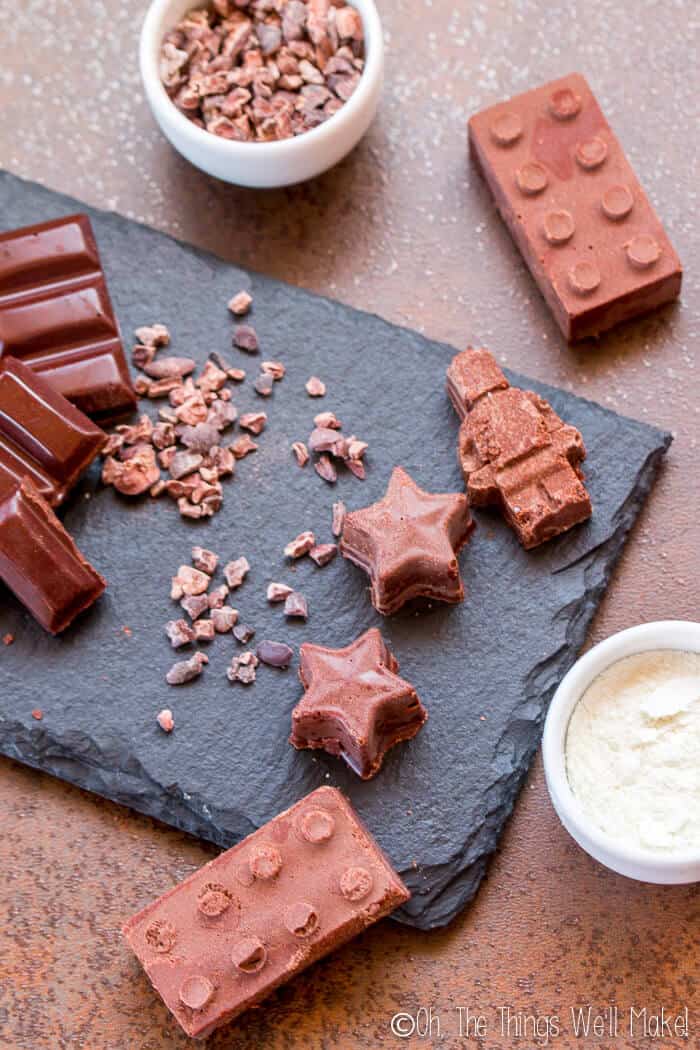
Should you temper homemade chocolate?
Tempering chocolate is a process done to get the fats in the cocoa butter to align correctly. Tempered chocolate is shiny in texture and snaps when broken into pieces. It’s prettier and has a nicer texture. Chocolate that hasn’t been tempered will be duller in appearance and can bloom quickly.
I didn’t bother trying to temper either of the chocolates, mainly because they were already going to be slightly grainy anyway. For me, this was more of a fun experiment. If I had a melanger (chocolate refiner) and were working to make a more professional grade chocolate, I would be more concerned with trying to temper the chocolate. I think I ended up being lucky with my homemade dark chocolate as it seemed to have fallen into temper on its own. You can help improve your luck by checking the temperature when you are about to pour the chocolate into the molds. If it’s around 31-32ºC (88-90ºF) it may fall into temper on its own.
How to temper homemade chocolate
I’m not going to go into a lot of detail here as there are many people who have written about how to temper chocolate know a lot more about the subject than I do. I will say, though, that there are several ways to temper chocolate if you choose to do so.
Seeding method
If you’re making your chocolate from scratch, you can’t really use the popular “easy” way of tempering chocolate called “seeding” unless you already have a batch of homemade tempered chocolate available. Seeding is basically adding a small amount (1/4th-1/3rd of the total chocolate amount) of already tempered chocolate to your hot, melted chocolate (around 49ºC/120ºF for dark or 46ºC/115ºF for milk chocolate). Cooling your chocolate down with the tempered chocolate helps temper the entire batch. You’ll want to cool to around 32ºC/90ºF for dark chocolate or 30ºC/86ºF for milk chocolate.
Temperature method
If you don’t have tempered chocolate available, you can temper it by raising and lowering the temperature. First, you’ll want to heat the chocolate over a double boiler until you reacharound 49ºC/120ºF for dark or 46ºC/115ºF for milk chocolate. Next, you’ll want to cool the chocolate over ice or over a marble slab (being careful not to allow even a drop of water into the batch or it may sieze). You’ll want to cool dark chocolate to 28ºC/82°F, milk chocolate to 27ºC/80°F. Finally, you need to reheat the chocolate to32ºC/90ºF for dark chocolate or 30ºC/86ºF for milk chocolate.
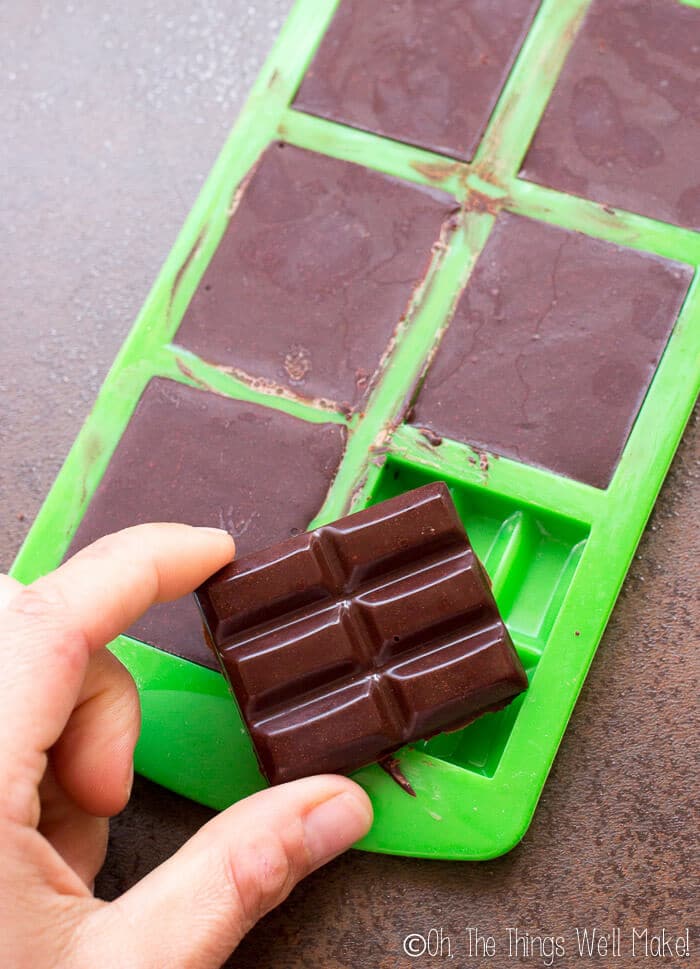
Roasting the chocolate nibs
I didn’t bother roasting the chocolate nibs before grinding them because I wanted to see what a “raw” homemade chocolate would taste like, but many people prefer roasting the nibs before grinding them into chocolate. To roast them, spread them out over a baking pan and bake them at around 150ºC (300ºF). You’ll want to check on them after around 10 minutes, and then after that keep a close eye on them to ensure they don’t burn. The roasting process should take 10-15 minutes, until the chocolate gives off a pleasant, baked chocolate aroma.
Homemade Chocolate From Cocoa Nibs
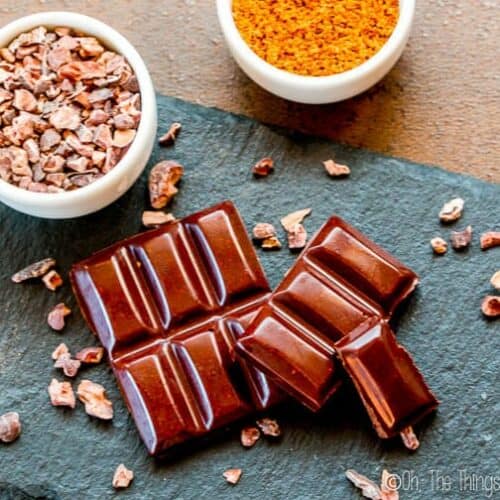
Homemade Chocolate 85%
Nutritional information based on a 12.5g serving.
Ingredients
- 425 g cacao nibs
- 75 g sugar
Instructions
- If you choose to roast your cocoa nibs, roast them in the oven at 150ºC/300ºF for 10-15 minutes.
- Add the cocoa nibs and sugar to your blender or high powered food processor and begin to blend. At first you’ll end up with a chocolate paste.
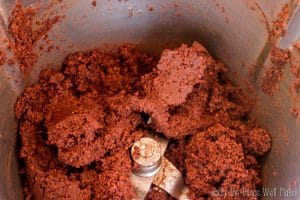
- Continue blending until you start to obtain a liquid, melted chocolate.
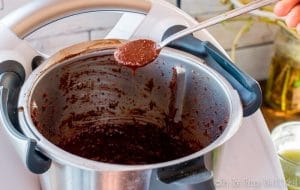
- Pour the chocolate into molds and allow to cool.
- Remove the cooled chocolate from the molds and enjoy your homemade chocolate.
 Español
Español


 Goat Milk Soap with Honey
Goat Milk Soap with Honey
AJ
So, I hate to tweak things BUT this was a great recipe. I did however, just roast the nibs, and put all ingredients in my Vitamix. I used the soup setting and boom! Perfect chocolate. Not gritty at all. I didn’t temper either and it can out shinny and smooth! Try it! It is so easy and tasty! Thank you for this ingredient ratio, it worked!
AJ
Wanted to add I did also try Coconut Oil instead of butter and that worked, I also added a pinch of Vanilla extract.
Marissa
What a waste of perfectly good ingredients.
Isabelle
Hi Tracy,
I have a thermomix too! Could you share how much time, temperature and speed to use? Thank you!
Tracy Ariza, DDS
Hi Isabelle,
I haen’t made this in a while, but I remember starting with the lower speeds (5-6) and slowly moving up to the top speed. I didn’t need to add a temperature as it gives off heat as it grinds. I kept grinding until it was quite liquid and I didn’t see any improvement in texture anymore. I’m guessing it was probably easily going for more than 10-15 minutes, but it probably was unnecessary to go that long as it will end up being slightly grainy no matter how long you grind in the Thermomix. (Or that’s what I’m guessing.) It’s not practical to keep it going longer.
Diann Bottorff
This is a terrible gritty gross chocolate bar
Tracy Ariza, DDS
I warned that when made with home equipment, the bar is gritty and better for chewing. It isn’t meant for melting in your mouth, unless you use more professional equipment and are able to get the mixture smoother. I think it’s a fun project to do, though, to see how chocolate is made.
Ben
Hi Tracy –
I liked the simplicity of your recipe of just two ingredients because I didn’t have cacao butter on hand. I used Cacao Mae brand cacao nibs (Dominican Republic) – excellent quality (http://cocoamae.com/) and coconut sugar. I used your ratio and though I like dark, bitter chocolate, I still had to add a little more sugar. I also put some vanilla extract in. Blending it for quite awhile produced a nice chocolate paste, but it was still a little thick. So I heated it up a little over low heat and added some coconut oil and it came out great. Thanks for the kick to get me going on this. All the best.
Ben
Cape Ann MA
USA
Tony Harvey
Thanks for the recipe. I want to make hot chocolate from 1Kg of cocoa nibs I bought. If your recipe converts the nibs to chocolate (with adding milk & sugar after) I am hoping it will work. Your recipe basically roasts then blends/grinds. Thanks again. If you have any other tips for converting the nibs to a powder suitable for making into hot chocolate then I would appreciate them.
Tracy Ariza, DDS
Hi Tony,
This recipe results in a high fat chocolate mixture. I imagine that it could work, but you’d need to use a high fat liquid…so whole milk vs. Skim, or you may even need to add some heavy whipping cream.
When they make cocoa powder,the de-fat it somehow so that it can be in a powder form that is water soluble. I doubt you would be able to do that at home.
If you tried to mix this with skim milk or water, I doubt it would incorporate into the liquid.
Alisa
This was my first time making chocolate from scratch and all I can say is…WOW! Store-bought chocolate does not even come close to how rich this chocolate tastes! I used a cup of raw organic cacao nibs and 1/8 of a cup of powdered sugar. I used a Cuisinart blender for most of the process but I found an immersion blender helped the mix turn into a paste quicker than the blender. My only comment with regards to this recipe is that it took about 30 min for my chocolate to liquify rather than 5 min. I almost gave up until I saw the mix coming together and clumping. Glad I didn’t! Thank you for sharing, who knew making chocolate was this easy?!
Tracy Ariza, DDS
It will depend on the temperature of your room, probably- and the power of the processor being used. My Thermomix is very powerful, so that could be why it went so quickly in my case.
SHELAGH HARROP
Could you please give the speeds and times for the Thermomix method?
Tracy Ariza, DDS
Hi Shelagh,
I don’t remember how long, exactly, it took.
I started on lower speeds and moved up to 10 when I could.
I kept blending until it was a mostly smooth liquid.
The time can vary even with the ambient temperature, the newness of your blades, etc.